A new multi-scale method to reveal hierarchical modular structures in biological networks†
Abstract
Biological networks are effective tools for studying molecular interactions. Modular structure, in which genes or proteins may tend to be associated with functional modules or protein complexes, is a remarkable feature of biological networks. Mining modular structure from biological networks enables us to focus on a set of potentially important nodes, which provides a reliable guide to future biological experiments. The first fundamental challenge in mining modular structure from biological networks is that the quality of the observed network data is usually low owing to noise and incompleteness in the obtained networks. The second problem that poses a challenge to existing approaches to the mining of modular structure is that the organization of both functional modules and protein complexes in networks is far more complicated than was ever thought. For instance, the sizes of different modules vary considerably from each other and they often form multi-scale hierarchical structures. To solve these problems, we propose a new multi-scale protocol for mining modular structure (named ISIMB) driven by a node similarity metric, which works in an iteratively converged space to reduce the effects of the low data quality of the observed network data. The multi-scale node similarity metric couples both the local and the global topology of the network with a resolution regulator. By varying this resolution regulator to give different weightings to the local and global terms in the metric, the ISIMB method is able to fit the shape of modules and to detect them on different scales. Experiments on protein–protein interaction and genetic interaction networks show that our method can not only mine functional modules and protein complexes successfully, but can also predict functional modules from specific to general and reveal the hierarchical organization of protein complexes.


 Please wait while we load your content...
Please wait while we load your content...